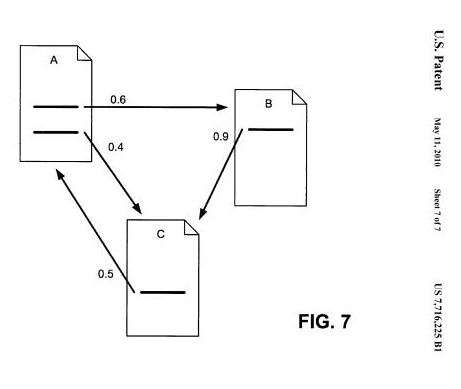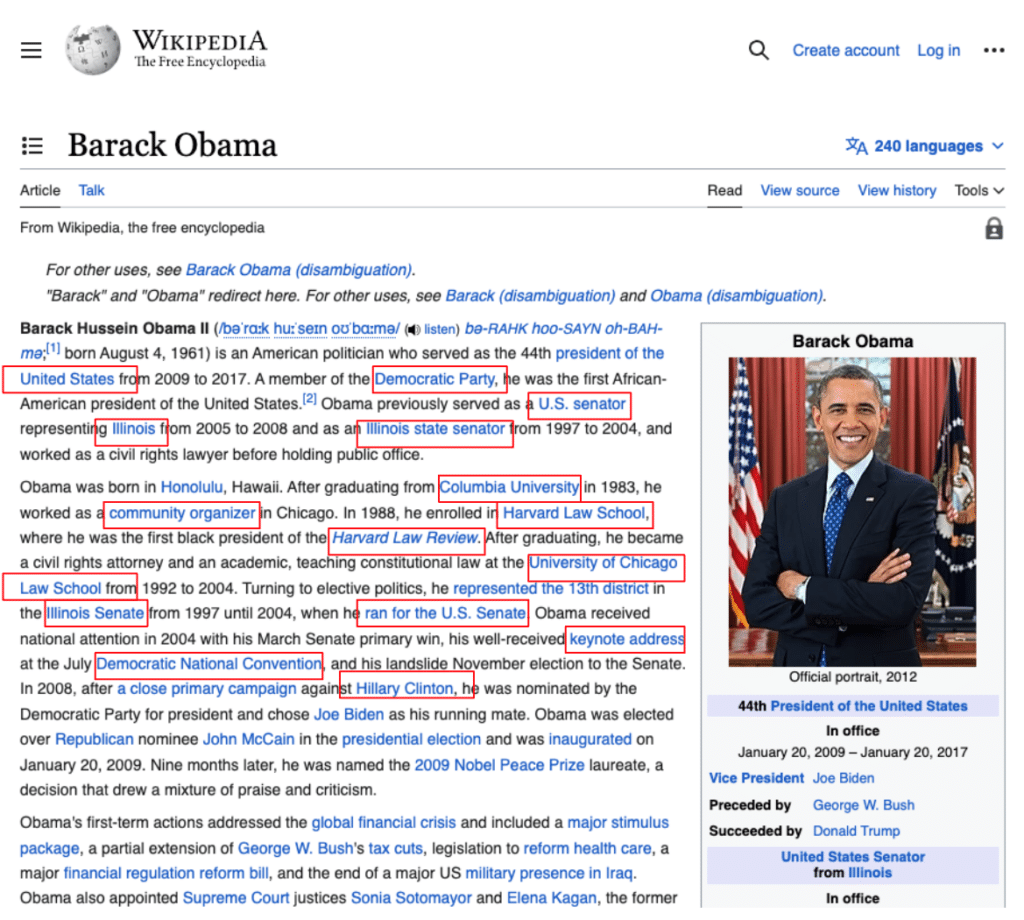Home / Blog / Fundamentals / What Is Anchor Text (And How To Optimise It)
What Is Anchor Text (And How To Optimise It)

May 31, 2023
Share to
Anchor text – Sounds like something a sailor might talk about, right? Well, unless that sailor is also a web developer, probably not. In the digital world, anchor text refers to the clickable words used to link one webpage to another. You’ve probably clicked on hundreds, if not thousands of these without even realising it.
They are usually highlighted or underlined text in a distinct colour (often blue) that indicates “Hey, click me! I’ll take you somewhere else on this vast ocean known as the internet.” Now, if the anchor text says “chocolate chip cookie recipe” and you click it, you’d expect to be transported to a page about exactly that. You wouldn’t be too chuffed if you ended up on a page about car engines, would you?

The Importance of Anchor Text in SEO
Now, you might be thinking, “Cool, I got it. But why does it matter?” It’s a great question, and here’s where we enter the realm of Search Engine Optimization (SEO), the mysterious art of pleasing Google’s almighty algorithms.
You see, search engines are like detectives. They crawl, inspect and try to understand every nook and cranny of your website. Anchor text is one of the clues they use to figure out what a page is about. If the anchor text says “chocolate chip cookie recipe” and it leads to a page full of delicious cookie content, the search engine says “Aha! This makes sense.”
When this alignment happens consistently across your site, you build credibility with search engines. They start to trust that you’re not playing games, you’re providing value, and you mean what you say. This trust can translate into higher rankings in search results, which means more visibility, more visitors, and ultimately, more conversions.
Detailed Explanation of Anchor Text
Alright, so we’ve laid the groundwork. You’ve got a handle on what anchor text is and why it’s important. But how does it actually work? And are all anchor texts created equal? Let’s dig deeper.
How Anchor Text Works in the SEO Landscape
Anchor text plays a crucial part in SEO, serving as a beacon to guide search engines to the relevance and context of linked content. It’s not just the human users that notice what the clickable text says; search engines are paying attention too.
In fact, Google, our friendly neighbourhood search giant, uses anchor text as one of the many factors to decipher the subject matter of a web page. When you link a page using specific anchor text, you’re essentially giving the search engine a hint about what the target page is about.
But remember, subtlety is the name of the game here. Too much “on the nose” anchor text can seem spammy, and Google doesn’t like spammy. More on this later.
Types of Anchor Text
As for types of anchor text, it’s not a one-size-fits-all deal. There’s quite an array of options to choose from. It’s like choosing the right pair of socks for an occasion (okay, maybe it’s a bit more important than that).
- Exact Match Anchor Text: This is when your anchor text is the exact keyword or phrase for which you’re trying to rank. Let’s say you’re looking to rank for “handmade wooden tables” – the anchor text would be precisely “handmade wooden tables”. If overused, it can look unnatural and potentially incur penalties.
- Partial Match Anchor Text: Partial match is a bit less strict. It includes your target keyword but it’s nestled amongst other words. Sticking with our example, your anchor text might be “Where to find handmade wooden tables”. It gives a bit more wiggle room and looks more natural to search engines and users alike.
- Branded Anchor Text: This one’s simple. Your brand name is the anchor text. It’s a good way to build brand awareness and it’s generally safe from the wrath of Google’s penalties. Example: Keyword Insights.
- Branded + Keyword: This type of anchor text includes your brand name or phrase along with a keyword or contextual information. For example, “Check out Keyword Insight’s content brief generation tool” or “Read Keyword Insight’s guide to writing a great content brief“.
- Generic Anchor Text: This type uses common, non-specific phrases like “click here” or “learn more”. It’s not keyword-focused, but it’s natural and user-friendly, which Google appreciates. For example, “To see our keyword clustering tool, click here.”
- Image Anchor Text: Surprise, even images can be anchor text! If an image links to another page, the search engine will use the image’s alt text (the description of the image for those with visual impairments) as the anchor text.
- Naked URL Anchor Text: This is when you use the actual URL of a webpage as the anchor text, like www.snippet.consulting. It’s not particularly pretty or subtle, but it’s straightforward and user-friendly.
The right balance and variation of these types can make all the difference in your SEO efforts. As with many things in life, it’s all about balance. Now let’s continue our journey through the fascinating world of anchor text.
The Role of Anchor Text in Search Engine Algorithms
As we continue on our trek through the world of anchor text, we need to talk about the big players in this game: search engine algorithms. They’re like the secret agents of the internet, quietly influencing what content comes into the spotlight and what stays in the shadows. Let’s see how anchor text fits into their mission.
The Penguin Algorithm Update and its Impact on Anchor Text

Let’s rewind the clocks a bit to 2012, the year when Google released its infamous Penguin update. You’re probably wondering, “What do flightless birds have to do with SEO?” Not much, really, but it did change the landscape of anchor text usage.
Before Penguin, the SEO world was a bit like the wild west. It was common practice to heavily use exact match anchor text to improve rankings. Google saw this as gaming the system, and it was about as welcome as a bull in a china shop.
Enter Penguin, swooping in to restore order. The update aimed to decrease the rankings of sites that were manipulating search results through excessive use of exact match anchor text, amongst other spammy tactics. Post-Penguin, the mantra has been clear: over-optimisation of anchor text is a no-go.
How Search Engines Use Anchor Text to Understand and Rank Content
So how do search engines, like our friend Google, use anchor text in their algorithms? Well, they treat it as a contextual clue. Think of it as labelling a jar of homemade jam: the label (or the anchor text) gives a hint about what’s inside the jar (the linked page).
Search engines crawl and index billions of webpages, and anchor text helps them understand the relevance and quality of a page’s content. If a page about “dog grooming tips” is frequently linked with that exact anchor text, search engines can infer that the page probably provides valuable content about dog grooming.
But remember, balance is key. If every single link to that page uses the exact same anchor text, it could come off as unnatural or spammy. This is why a diverse mix of anchor text types – exact match, partial match, branded, generic, and so on – is vital for healthy SEO.
In the grand scheme of things, anchor text is just one piece of the puzzle in search engine algorithms. However, it’s an important piece, acting as a guidepost to both the relevance and the quality of the linked content. Understanding this can help you to create a more effective SEO strategy. But remember, great SEO is about creating great content first and foremost and then using techniques like thoughtful anchor text to highlight that content.
Advanced SEO – The Reasonable Surfer Model and Its Impact on Anchor Text
Google’s PageRank algorithm follows what its inventor called the Random Surfer Model. It ranked pages on the Web on the probability that a person following links at random might end up on a particular page:
The page’s rank can be interpreted as the probability that a surfer will be at the page after following many forwarding links. The constant α in the formula is interpreted as the probability that the web surfer will jump randomly to any web page instead of following a forward link.
Consequently, the Reasonable Surfer model plays a key role in understanding the nuances of anchor text optimisation.
This is a patented model used by Google to determine how much value to assign to a hyperlink based on the likelihood that a user would click on it. The model assumes that a “reasonable surfer” is more likely to click on some links than others, even within the same webpage. The patent can be found here.
In this model, not all links are seen as equally important. Instead, the probability of a user clicking a link (and hence its value) depends on various factors – the anchor text and its characteristics being a few of them.

Factors Influencing the Reasonable Surfer Model
- Font Size and Colour of Anchor Text: The model considers the size of the font used for anchor text. Larger text may draw more attention, and therefore more likely to be clicked. Likewise, the colour of the anchor text can influence visibility and click-through rates. For example, if anchor text colour blends in or matches the rest of the colour of the text on the page, it’s unlikely to pass as much “equity” according to this model.
- Position of the Link: A link’s position on the page can impact its likelihood of being clicked. The model considers whether a link is in the main body text, a sidebar, a footer, or above or below the first visible screenful of an average browser display. For example, links higher up on the page, within the body of text, are likely to pass more “equity” according to this model.
- Position in a List: If the link is part of a list, the model takes into account its position within that list.
- Number of Words in Anchor Text: The number of words within the anchor text can influence click probability.
- Words Used in the Anchor Text: The actual words used in the anchor text, including their relevance and commercial nature, can impact the likelihood of a click.
- Type of Link: Whether the link is text or an image can also affect click-through rates. If it’s an image link, the aspect ratio of the image may be a factor.
- Surrounding Context: The model considers the context of words immediately before and after the link.
- Topical Cluster Associated with Anchor Text: The topic related to the anchor text of the link can influence click probability.
- Destination of the Link: Whether the link leads to the same host or domain can influence user behaviour. If it’s on the same domain, the model may consider if the link URL is shorter than the referring URL or if the link URL embeds another URL for redirection.
In essence, the Reasonable Surfer model emphasises the importance of user experience and how different factors can influence a user’s likelihood to click on a link. Therefore, when optimising anchor text and link placement, these elements should be considered to create a user-friendly and SEO-friendly webpage.
The Impact of Anchor Text on User Experience
We’ve spent a lot of time talking about how search engines view anchor text, but let’s not forget about another incredibly important group – the users. Yes, the human beings who click around, skim content and hunt for information. Let’s delve into how your choice of anchor text impacts the user experience.
Readability and Relevancy
Imagine you’re reading a beautifully written article about the best places to travel in Europe. Suddenly, you see a blue, underlined phrase, “check out these tips,” but you’ve got no clue what tips the article refers to. Is it tips about packing? Saving money? Navigating airports? You’d be clicking blindly, and nobody likes that.
This is where relevancy and readability come into play. Anchor text should be self-explanatory. It should give the user a clear idea of what they’re about to dive into when they click on the link. The anchor text, “tips for backpacking through Europe,” is far more useful, readable, and relevant. By choosing anchor text that accurately represents the linked content, you’re improving the readability of your page and making the user experience smoother.
User Trust and Credibility
Your website is like a digital handshake. It’s often the first impression users have of your brand, and just as in real life, you want this handshake to be firm and trustworthy. The internet is chock-full of information, and not all of it is reliable. Users are more sceptical than ever, and they rely on signs of credibility before they invest their time (or their credit card details) into a site.
What does this have to do with anchor text? Well, consider an article that uses spammy or irrelevant anchor text. The page might be full of links that say “click here” or that lead to unrelated content. As a user, would you trust this page? Probably not.
Conversely, well-crafted, relevant anchor text shows that you’re mindful of your users. It suggests that you’re guiding them to valuable content, not trying to trick them or boost your SEO recklessly. This builds trust, and trust is the foundation of any successful website.
In conclusion, while it’s important to understand anchor text from an SEO perspective, don’t forget about your users. After all, you’re creating content for them. By prioritising readability, relevancy, and trust, your anchor text will not only please search engine algorithms but also your audience. And that’s the sweet spot we’re aiming for.
Strategies for Optimising Anchor Text
So, we’ve talked about what anchor text is, why it’s important, and how it impacts both SEO and user experience. Now it’s time to roll up our sleeves and get to work. How can you optimise your anchor text for the best results? I’m glad you asked.
Balancing Anchor Text Distribution
Let’s start with a straightforward concept: balance. Like a well-cooked meal, anchor text needs the right mix of ingredients. If your site is overflowing with exact match anchor text, it could trigger search engines to think you’re overdoing it. On the other hand, a site full of only generic anchor texts won’t give much context about the linked content.
The key is to use a blend of different types of anchor text – exact match, partial match, branded, generic, and so on. This creates a natural-looking link profile that’s both user-friendly and search engine-friendly.
Matching Anchor Text with the Target Page’s Content
This might seem like a no-brainer, but you’d be surprised how often it’s overlooked. The anchor text should accurately reflect the content of the page it’s linking to. If your anchor text reads “best Italian pasta recipes” and it leads to a page about how to knit a scarf, users are going to be confused and frustrated, and search engines won’t be too happy either. Always make sure that your anchor text and target page are in harmony.
Prioritizing Natural Language and Readability
Even though anchor text is a tool for SEO, it’s essential to remember that your primary audience is human. Anchor text should be written in a natural, readable way. Avoid stuffing it with keywords or making it sound awkward just to fit in a certain phrase. If it reads naturally and makes sense in the context of the surrounding content, you’re on the right track.
Avoiding Over-Optimization
Remember our chat about Google’s Penguin algorithm update? One of its main goals was to combat the over-optimisation of anchor text. This doesn’t mean you should avoid using exact match anchor text entirely, but rather that you should use it judiciously. Over-optimised anchor text can make your site look spammy and could potentially lead to penalties. As with many things in life and SEO, moderation is key.
Optimise Anchor Text to The Reasonable Surfer Model
We’ve touched upon the concept of “The Reasonable Surfer Model” and its purpose. So, how do we fine-tune our anchor links in line with this model?
- Consider Link Placement: Place important links where users are more likely to see and click on them. The upper part of the page and the beginning of the content sections often attract more attention.
- Make Anchor Text Stand Out: Use a font size, colour, or style that makes your anchor text noticeable. However, avoid going overboard – your anchor text should be visibly clickable but not disruptive or jarring.
- Contextual Relevance: Ensure the anchor text is relevant to the surrounding content and gives a clear indication of what users can expect from the linked page.
- Use Descriptive Anchor Text: Include keywords that accurately describe the linked page. This will help both users and search engines understand the relevance of the link.
- Be Concise: Keep your anchor text concise yet descriptive. A few well-chosen words often work better than long phrases.
- Balancing Internal and External Links: It’s essential to maintain a balanced and natural mix of internal and external links. Too many of either could make your content seem manipulative.
- Avoid Over-Optimisation: While it’s important to include relevant keywords in your anchor text, avoid stuffing your anchor text with keywords. This could be seen as manipulative by search engines.
- List Positioning: If your link is part of a list, its position may affect click-through rates. Users are generally more likely to click on the first few links in a list.
By considering these factors in line with the Reasonable Surfer model, you’ll likely improve the click-through rates of your links, provide a better user experience, and potentially improve your SEO.
Using Anchor Text in Internal and External Links

Anchor text plays a pivotal role in both internal and external links. Internal links are those that direct to another page on the same website, while external links either point from your website to a different one, or vice versa.
With internal links, anchor text aids in defining site structure and distributing link equity. For instance, while writing a blog post about homemade pasta recipes, you might create internal links with anchor text such as “our pasta maker reviews” or “choosing the best pasta flour”, thereby guiding your reader to related content within your website.
Shifting the focus to external links, they can either be outbound from your website or inbound to your site. Outbound links typically reference sources or provide additional context for your readers. It’s crucial that the anchor text for these links is clear and indicative of the content it’s linking to, enhancing user experience by providing context and expectation.
Inbound external links, on the other hand, could be organic (other websites linking to yours without your intervention) or a result of your link-building efforts. In the case of organic links, you generally have no control over the used anchor text. But when you’re actively link-building (a recommended practice by many SEO professionals for boosting authority and improving rankings), you may influence the choice of anchor text. Like your internal links, avoid over-optimisation and aim for a diverse anchor text profile.
Regardless of whether the links are internal or external, always ensure that your anchor text offers transparent, relevant, and beneficial navigation for your users.
Case Studies and Examples
Enough theory. Let’s bring it all together with some real-world, successful examples.
BBC News: When it comes to using anchor text effectively, news sites like BBC are worth studying. They often use anchor text that is relevant, concise and gives a clear idea of what the linked page contains. For example, in an article about AI and its safety, they link to a previous article with the anchor text “could lead to the extinction of humanity”, providing context and inviting readers to delve deeper into the topic.

Wikipedia: Wikipedia excels in anchor text usage by maintaining a balance between user experience and SEO. It uses descriptive, contextually relevant anchor text for internal linking, avoiding over-optimisation. This approach enhances readability, fosters user engagement, and provides a clear context for search engines, serving as an effective model for an effective SEO strategy.

Tools and Resources for Anchor Text Optimization
Having the right tools and resources can significantly simplify the process of anchor text optimization. Let’s dive into some recommended ones that can assist you in your SEO journey.
Recommended SEO Tools for Analyzing and Tracking Anchor Text
- Moz’s Link Explorer: This tool helps you understand your site’s link profile, including details about anchor text. It identifies the most common anchor text phrases used on your site and provides insights on follow and no-follow links.
- Ahrefs: A comprehensive SEO tool, Ahrefs includes an “Anchor Text” report within its Site Explorer feature. This report provides information about your site’s anchor text distribution, helping identify patterns, anomalies, or areas for improvement.
- Majestic: Majestic’s site explorer offers an anchor text report, allowing you to see which words and phrases are most commonly used as anchor text on your site. This can be useful in maintaining a balanced and diverse anchor text profile.
- SEMrush: This is another all-in-one SEO tool that provides anchor text analysis as part of its backlink analytics section. You can see the anchor texts used for your site’s incoming links, which can help inform your link-building strategy.
Conclusion
As we bring this guide to a close, let’s recap what we’ve covered and finish with some final thoughts and tips on mastering the art of anchor text optimisation.
Anchor text, a key player in SEO, aids search engines in comprehending linked content, enhancing your site’s visibility. Equally vital is its role in user experience, aiding navigation and trust-building through relevant, readable content.
Optimising anchor text requires a balanced approach. Diversify anchor text types for a natural link profile, avoid over-optimisation, and ensure relevance between anchor text and linked content. Tools like Moz, Ahrefs, Majestic, and SEMrush can provide valuable insights. Learning from successful examples, like Wikipedia, and avoiding common pitfalls are also crucial. Remember, anchor text optimisation is a continuous process that requires patience and persistence. Keep refining your strategies for a successful website.
Happy optimizing!
Other FAQs
Do all links need anchor text?
Indeed, all links typically require anchor text for two primary reasons. Firstly, it provides context for the linked content, both for users and search engines. Secondly, it helps improve accessibility, especially for visually impaired users who use screen readers. Without anchor text, a link becomes a disconnected piece of the website with no clear purpose or destination.
How many keywords should be in my anchor text?
When it comes to keywords in anchor text, it’s a game of quality, not quantity. Ideally, your anchor text should include one relevant keyword that accurately represents the linked content. However, the primary focus should be on creating natural, descriptive, and user-friendly anchor text. Over-stuffing your anchor text with keywords may lead to penalties from search engines for over-optimisation.
Can anchor text impact my site’s search engine ranking?
Absolutely! Anchor text plays a critical role in SEO. It helps search engines understand the context and relevance of the linked content, which can influence your site’s search engine ranking. A well-optimised anchor text strategy, balanced with relevant keywords and diversified with various types of anchor text, can enhance your SEO performance.
How can I avoid being penalized for over-optimized anchor text?
Over-optimised anchor text, often characterised by excessive keyword stuffing, can indeed lead to penalties from search engines. To avoid this, follow these strategies:
1) Diversify your anchor text: Use a variety of anchor text types, including branded, generic, naked URL, and others.
2) Prioritise natural language: Your anchor text should read naturally within the context of your content. Forcing keywords into your anchor text where they don’t naturally fit can harm readability and potentially lead to penalties.
3) Match anchor text with linked content: Ensure your anchor text accurately represents the content it’s linking to. Misleading anchor text can harm your SEO and user experience.
4) Use relevant keywords moderately: While keywords in anchor text can be beneficial for SEO, stuffing your anchor text with them can be counterproductive. Use them sparingly and appropriately.
Start your trial today for only $1
Sign up today for a $1 trial and enjoy access to 6000 keyword clustering credits, 3 Keyword discovery searches, 1 Content Brief and Pro versions of SERP Similarity, SERP Explorer.
Subscribe to our newsletter
Subscribe to get our latest news, offers, insights, and any updates.

